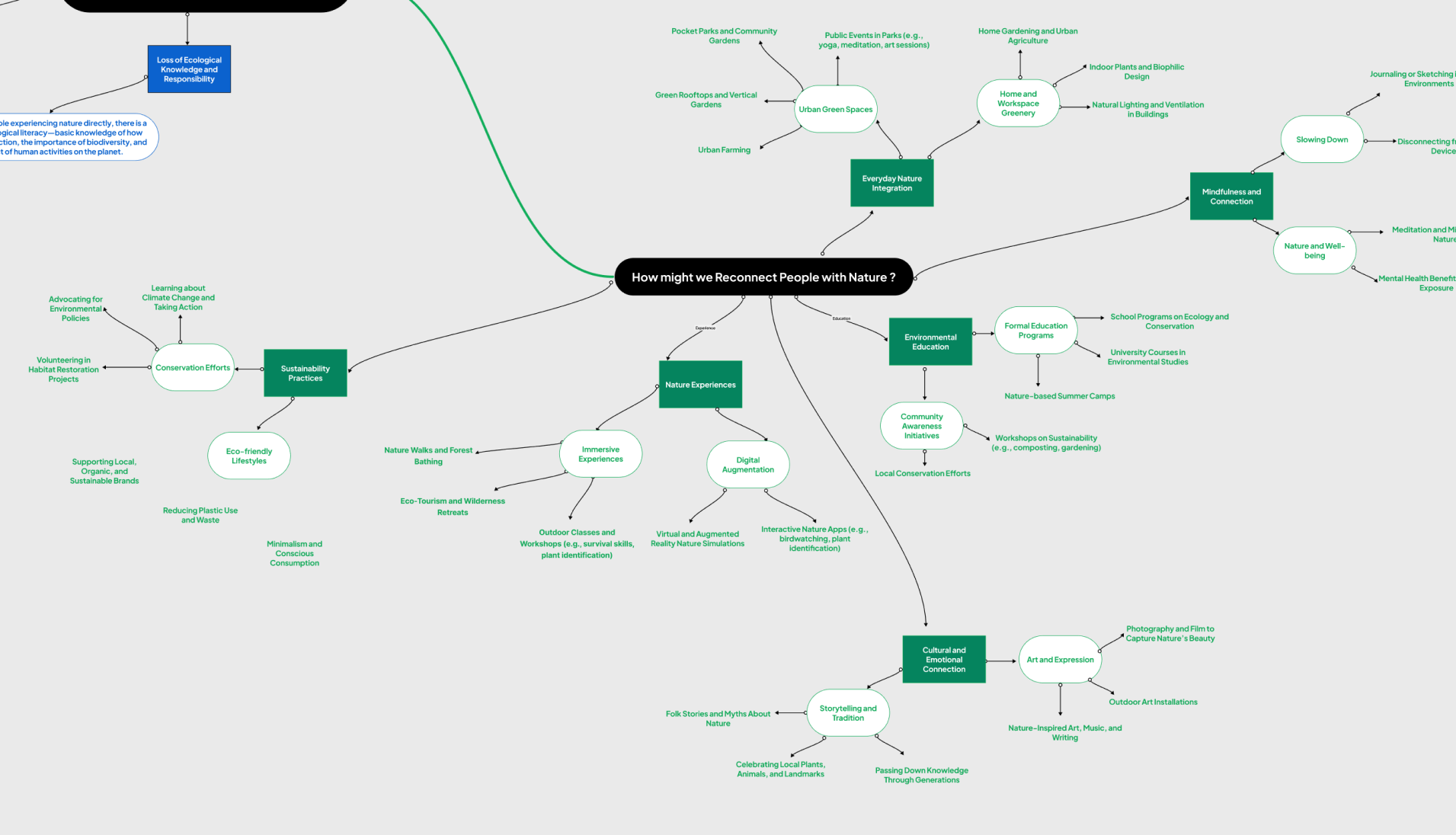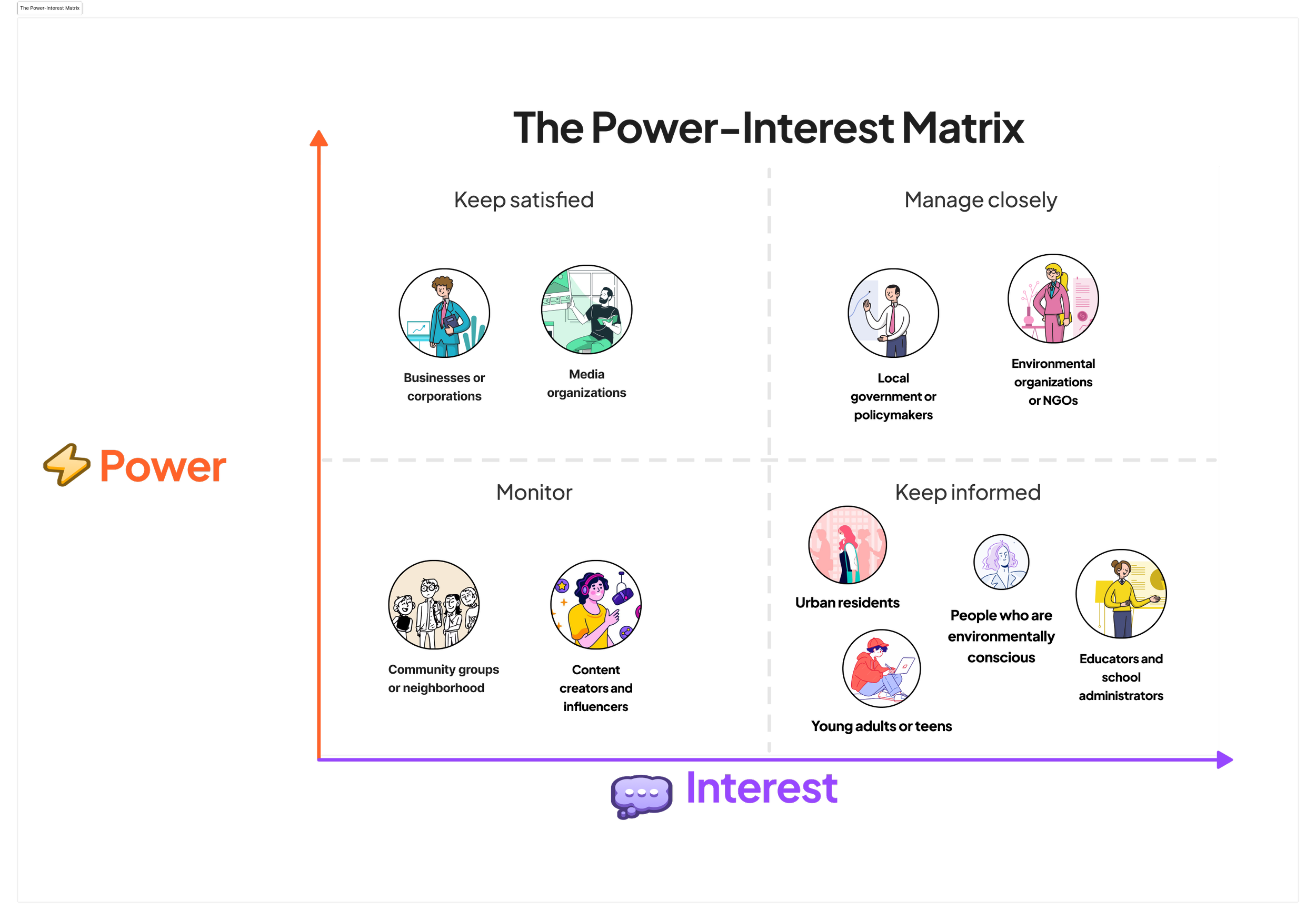A cycle of how human actions and behaviors impact the environment, which in turn negatively affects people themselves.
It shows that when people take certain actions that harm nature, it leads to environmental degradation. This degradation then causes negative consequences, like pollution or loss of resources, which ultimately have a detrimental effect on human well-being.
Mind mapping
I started mind mapping by focusing on the problem: what are the environmental issues, and what's happening? I identified key issues like air pollution, brownfields, plastic waste in the oceans, climate change, and global warming. These problems impact people’s physical and mental well-being, from heatwaves to deteriorating air quality.
After creating the first diagram, I realized that these issues result from human actions toward the environment. So, my next question was, why is this happening? I found that the root causes are human activities, such as overuse of plastic containers, neglect of environmental issues, land misuse, monoculture farming, deforestation, and lack of environmental knowledge.
As I mapped this out, I felt that all these problems stem from a disconnection from nature. This disconnect leads people to engage in harmful actions without fully understanding their impact.
With this insight, I created a mind map exploring ideas for how we might help people reconnect with nature.
Reflecting on this process, I found that mind mapping is valuable for uncovering root causes and understanding the connections, relationships, and cause-and-effect dynamics within complex issues.
Storyboard
Process
Identifying the Problem: I began by exploring environmental issues like polluted air, plastic waste in the oceans, and climate change, recognizing how they impact people’s physical and mental health.
Understanding Causes: Next, I questioned why these problems exist, pinpointing human activities—such as deforestation, overuse of plastics, and industrial farming—that harm the environment.
Finding a Core Cause: Through my mapping, I realized that many environmental problems stem from a broader issue: humans’ disconnection from nature.
Ideating Solutions: This insight led me to brainstorm ways to help people reconnect with nature, believing that rekindling this bond could encourage sustainable practices and reduce harmful behaviors.
Reflection: Mind mapping has helped me visually unpack the complex relationships between human actions, environmental degradation, and potential solutions. By organizing my thoughts this way, I’ve gained a clearer perspective on root causes and interconnected effects.
Stakeholder Mapping
Core Audience: These are the people we’re really trying to reach. They’re the ones most affected by this project and who we want to inspire to connect more with nature and adopt eco-friendly habits.
Who They Are: Think young adults or teens who might be curious but don’t know much about the environment yet, people living in cities who don’t have much access to nature, and eco-conscious folks who want tips on going greener.
Direct Stakeholders: These groups or individuals play a big role in making this project happen. They’re not the main focus, but they help us reach the core audience and spread the message.
Who They Are: Educators, environmental groups or NGOs, local policymakers, and influencers who talk about sustainability. They can help teach, share, or even make policies that encourage people to reconnect with nature.
Secondary Stakeholders: These people or groups aren’t directly involved in the project, but they could still benefit from or support it.
Who They Are: Businesses, neighborhood groups, and media outlets. They can help spread awareness, support eco-friendly initiatives, or encourage sustainability within their networks.
Research Question
What are the primary motivators for people to engage in eco-friendly behaviors?
What obstacles do people face when trying to adopt sustainable practices, and how can we design around these?
How do people in urban areas currently connect with nature, and what opportunities exist to strengthen this connection?
What types of environmental issues are people most aware of, and how does this awareness influence their actions?
How do people perceive the impact of their individual actions on the environment?
In what ways can digital or augmented experiences bring people closer to nature and encourage sustainable behaviors?
How does a sense of community influence people’s willingness to participate in environmental efforts?
What role does convenience play in people’s decisions to engage in eco-friendly behaviors?
How might we design educational experiences that appeal to people with varying levels of environmental awareness?
What kinds of nature-inspired activities would people be willing to integrate into their daily lives, and what barriers might prevent them?
Which experiences for reconnecting with nature would you be interested in? (Select all that apply)
A. Nature tour platform
Access a variety of eco-tourism locations that you can book.
B. Web AR visualization
Use a "time machine" slider to see before-and-after views of environmental changes through augmented reality.
C. Zero-waste membership
Join a program where you earn points for sustainable actions, which can be redeemed for eco-friendly products.
Prototype Storyboard
B. Web AR visualization
Use a "time machine" slider to see before-and-after views of environmental changes through augmented reality.
3 Votes
B. Web AR visualization
Use a "time machine" slider to see before-and-after views of environmental changes through augmented reality.
3 Votes
A. Nature tour platform ***
Access a variety of eco-tourism locations that you can book.
6 Votes
C. Zero-waste membership
Join a program where you earn points for sustainable actions, which can be redeemed for eco-friendly products.
3 Votes
Case studies
3D Interactive Website
An Immersive Trailer for Opera North’s production
What is missing?
What Is Missing? is a multi-sited memorial created by Maya Lin to raise awareness through science-based artworks about the present sixth mass extinction of species, connect this loss of species to habitat degradation and loss, and emphasize that by protecting and restoring habitat, we can both reduce carbon emissions and protect species.
Uncommon Knowledge: Practices and Protocols for Environmental Information
The databases that landscape architects rely on to design future-oriented infrastructure—the SHP files and CSVs that describe a site’s climate, plants, and soils, often involve inadvertently appeal to extractive forms of knowledge production and storage. What if we were to design information infrastructures, both physical and digital, that are premised on collective ownership as opposed to existing systems that privatize, accumulate, and collect? This thesis responds to the contemporary environmental information economy at the site of Google’s first hyperscale data center in water stressed The Dalles, Oregon. On the ban
Rewild our planet
Augmented Reality, Web AR
An Immersive AR Nature Experience, a multi-sensory experience that repairs the connection between human beings and the natural world, based on the Netflix original documentary series Our Planet. This mobile ARCore application uses cutting edge immersive technologies to build compassion for our fragile world. Each realistic 3D biome emphasises the beauty of the natural world, but also the role humans play in reversing the loss of nature.
WWF Deutschland : Native Wildlife AR
WWF is accompanying wild animals that were once extinct in Germany on their way back. To support this mission of one of the largest international non-governmental organziations for wilderness preservation, we at Demodern developed a WebAR application to raise awareness about the endangered animals.
Wild Immersion Experiment Nature
Travel Through Nature, Solve Riddles and Encounter Animals in Augmented Reality. Engage in educational experiences with Augmented Reality (AR)! This interactive activity encourages collaboration as players work together to solve riddles and uncover virtual animals. It’s an innovative approach to deepening understanding and appreciation for wildlife.
Prototype Storyboard
B. Web AR visualization
Use a "time machine" slider to see before-and-after views of environmental changes through augmented reality.
3 Votes
B. Web AR visualization
Use a "time machine" slider to see before-and-after views of environmental changes through augmented reality.
3 Votes
A. Nature tour platform
Access a variety of eco-tourism locations that you can book.
6 Votes
C. Zero-waste membership
Join a program where you earn points for sustainable actions, which can be redeemed for eco-friendly products.
3 Votes






















